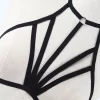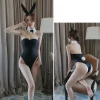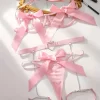We ship products to USA,Canada!
The Historical Evolution of Sexy Lingerie Design
Initially, lingerie was created with a focus on function rather than form. In the late 19th and early 20th centuries, corsets and undergarments were designed to mold the female body into socially accepted shapes, particularly the coveted hourglass figure. However, these designs were often restrictive and uncomfortable, limiting movement and even affecting health.
The shift toward comfort came in the mid-20th century, as designers like Christian Dior began to embrace the idea of glamour in lingerie. With the rise of the ready-to-wear industry, lingerie was no longer just an undergarment—it became a fashion statement. The 1950s and 1960s saw the introduction of lace, silk, and satin into mainstream lingerie designs, materials that brought femininity and allure to the forefront. At this time, Victoria’s Secret emerged as a dominant player in transforming lingerie into a luxury item, integrating intricate designs and high-end fabrics into everyday undergarments.
Modern-Day Shifts in Lingerie Design
As societal norms evolved, so did the idea of sexy lingerie. The last decade has brought about a major revolution, driven by the body positivity movement, inclusivity, and the democratization of fashion. Designers today no longer see lingerie as just something for a specific “ideal” body type. Instead, modern designs celebrate diversity, offering styles that cater to all body shapes, sizes, and ethnicities.
This inclusivity has led to the expansion of size ranges, especially for brands that embrace plus-size bodies. In terms of design, we see a rise in more personalized and customizable options, with intricate lacework, strategic cut-outs, and mesh panels tailored to enhance different figures. For instance, corsets and bustiers are no longer about constriction but about accentuating natural curves, giving women the power to celebrate their own forms.
From a designer’s perspective, these modern trends challenge the notion of what’s traditionally considered “sexy.” While black, red, and lace remain staples, softer pastels and jewel tones are increasingly used to project a more sophisticated, understated sensuality. Brands like Savage X Fenty are breaking the mold with bold colors, high-fashion cuts, and inclusive campaigns that resonate with a younger, more diverse audience.
Materials and Technology Driving Lingerie Trends
Material innovation plays a critical role in the current trends of sexy lingerie. Modern lingerie designers are pushing boundaries by experimenting with new fabrics that combine aesthetics with comfort. Lace, which remains a classic, has evolved into more durable, stretchy versions, making it more comfortable for everyday wear. The rise of sustainable fashion has also introduced eco-friendly materials, such as organic cotton, bamboo fibers, and recycled polyester into lingerie collections, appealing to environmentally-conscious consumers.
One of the most exciting technological advances is the use of 3D printing in lingerie design. This technology allows for the creation of intricate, highly personalized patterns and designs that would be impossible with traditional methods. Designers are exploring the potential of 3D-printed lingerie to craft custom-fit pieces that not only look visually striking but also offer an unparalleled level of comfort.
Additionally, advancements in textile technology have introduced fabrics that are both breathable and shape-enhancing. Seamless construction techniques are being used to create lingerie that contours the body without any visible lines. This has led to a growing preference for body-hugging, sculptural designs, such as bralettes, bodysuits, and high-waisted panties, which combine sleekness with sensuality.
Cultural and Consumer Influences on Lingerie Design
In terms of cultural impact, the rise of social media has drastically changed how lingerie is marketed and consumed. Designers must now think beyond traditional retail and embrace a digital-first strategy. Influencers, celebrities, and everyday consumers alike now have a platform to showcase lingerie as part of their lifestyle, turning sexy lingerie into something aspirational yet accessible.
The intersection of pop culture and lingerie design is especially notable. Brands like Agent Provocateur and La Perla have positioned themselves as luxury labels, creating pieces that double as couture garments. On the other hand, the success of Rihanna’s Savage X Fenty has shown that embracing diversity, bold designs, and an edgy aesthetic can lead to mass-market appeal.
For today’s designers, it’s not just about following trends—it’s about leading them. Consumers expect lingerie to do more than look good; it needs to make a statement. Whether that statement is about body positivity, sustainability, or simply the joy of self-expression, the role of the designer has evolved to meet these demands.
Future Trends in Sexy Lingerie Design
Looking ahead, the future of sexy lingerie design is bright and innovative. Designers are increasingly focused on creating pieces that blend sensuality with functionality. We are likely to see more collaborations between lingerie brands and tech companies, producing garments that integrate smart textiles capable of adjusting to body temperature or providing real-time biometric feedback.
Customization will also become a more significant aspect of lingerie design. With advancements in 3D scanning and printing, consumers could soon have access to lingerie tailored precisely to their body’s unique dimensions. This trend, combined with sustainability efforts, could revolutionize how lingerie is produced, offering eco-friendly, custom-fit designs that minimize waste and maximize style.
In conclusion, sexy lingerie design has come a long way from its restrictive roots, evolving into a dynamic, fashion-forward industry that celebrates individuality and empowerment. Designers today are not just creating undergarments but are shaping a culture that embraces beauty in all its forms.





